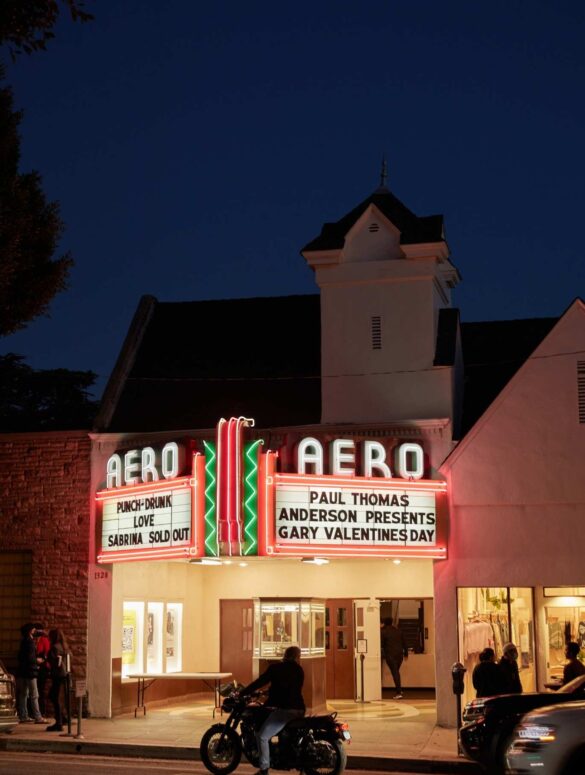Text by Kathy A. McDonald
Images by Cody James
Santa Monica’s 82-year old Aero Theatre still shows movies on one large screen—a rarity, as most vintage neighborhood theaters closed long ago. When the Aero Theatre opened in 1940, movies ran 24 hours a day to entertain the nearby Douglas Aircraft Company plant workers on day or night shifts. Built by the company’s founder and aviation pioneer Douglas W. Douglas, the name references his aerodynamic products.
Now the non-profit American Cinematheque manages the Aero’s varying repertoire that draws enthusiastic audiences to the 427-seat, fully renovated historic theater. Despite changing movie-going habits, competition from online streaming services and a disruptive 18-month pandemic closure, the theater thrives at its landmark Montana Avenue location.
The Aero is the Cinematheque’s Westside showcase, open to the public, supported by filmmakers, film studios, cinephiles from the world over, American Cinematheque members and above all, its Santa Monica neighbors. “At the American Cinematheque, we believe film is a communal experience with the power to entertain, enlighten and inspire,” explains Gwen Deglise, the arts organization’s deputy director and co-director of programming. The organization also programs Hollywood’s famed Egyptian Theatre (now under renovation) and one screen at the Los Feliz 3 in Los Feliz, east of Hollywood.


“The film programming first and foremost serves the community: our goal is to make sure we offer our members and audiences an eclectic, diverse and exciting slate of programs,” says Deglise, a French ex-pat and cinema fan, who’s been a key American Cinematheque administrator for 25 years.
The Cinematheque owes much to director Sydney Pollack (“Tootsie” “All The President’s Men”) one of the organization’s founders; much like Paris’ Cinematheque Francaise, Pollack envisioned a cinema for everyone, showcasing all film genres, new and old and from around the world. To that end, and essential to the Cinematheque’s core mission, is a best-in-class presentation.
Often this means projecting 35mm or even large-format 70-mm prints. A highly skilled projectionist is employed to actively monitor every screening. This archival aspect appeals to those who crave the authentic experience of seeing a movie on the big screen in its original format. There’s even a term for it: much like music fans who prefer vinyl records, format fetishists seek out films shown the way their filmmakers initially created them.
Screenings rarely are stand alone: Aero moviegoers can expect a film festival-like experience that puts the film’s origin, history or importance in context, often via an introduction from a filmmaker or film historian followed by question-and-answer session with those involved in the film’s production from actors to key behind-the-screen contributors such as cinematographers, directors and writers.
The Aero Theatre has many famous filmmaker fans who’ve premiered their work and sometimes drop in unannounced. Among those who cite the Aero as one of their favorite theaters are Paul Thomas Anderson (Oscar nominated for “Licorice Pizza”), Lulu Wang (2019’s “The Farewell”), Patty Jenkins (“Wonder Woman”), Wes Anderson (“The French Dispatch”), Guillermo del Toro (2017 Oscar best picture winner “The Shape of Water” and “Nightmare Alley”) and Jon Favreau (“The Jungle Book,” “Ironman,” “Elf”). Favreau is the Aero’s unofficial guardian angel per staff.

Going to a film at a theater or drive-in is much more than just watching a movie, it’s creating a personal experience…
April Wright
Past programs run the cinematic gamut from Oliver Stone and Val Kilmer discussing “The Doors,” to Al Pacino recounting his celebrated acting method in “Sea of Love,”
and more recently, director Amy Heckerling looking back at her iconic “Fast Times at Ridgemont High.”
Although programmers produce a varied repertory of showings, there are popular annual presentations moviegoers can count on. Marx Brothers comedies at the beginning of the year, “Jaws” close to July 4 th and “It’s a Wonderful Life” during the holidays. The most popular themed weekend (15 sessions so far) the Aero Horrorthon draws a devoted following when a dusk-to-dawn marathon of six or so horror film classics screen on the weekend before Halloween to devoted costumed crowds. Film buffs may even recognize the Aero from its appearances in “Get Shorty” and cult classic “Donnie Darko.”
The exterior of the theatre remains very much intact and true to its 1939 Streamline Moderne French-Normandy-style design. Carefully preserved interior historic architectural elements include female figure decorative motifs on the aisle seats (reminiscent of a goddess in flight), moderne glass and steel rest room signs, a glowing Glo-Dial blue-neon clock and large, platter-shaped, perforated light fixtures on the auditorium’s walls. Outside the brilliant, boldly graphic, signature Aero multi-colored neon-lit marquee and the entrance’s original swirling patterned terrazzo flooring declare the theater’s presence. The original, glass-enclosed, ticket office also survives, though it’s not in use.
Throughout the decades the Aero continued to exhibit first run films until the 1980s, when it became known for its bargain double features. When it closed in 2003 due to decreased attendance and financial issues, a prominent arts patron and producer Max Palevsky encouraged the American Cinematheque to step in to take over its operation. He helped fund the 2003-2005 renovation; the revived the movie-house (the formal name is the Max Palevsky Aero Theatre) included new seating, new projection equipment, a 44’x17’ screen and a contemporary concession stand. In 2019 a state-of-the-art sound system was installed. A new HVAC filtration system was installed during the pandemic closure and the lobby vibrantly repainted.

“The Aero is a pretty unique venue and provides a different experience,” says film historian and documentary filmmaker April Wright (her documentary “Going Attractions: The Definitive Story of the Movie Palace,” airs on Turner Classic Movies). Places like the Aero are known as “neighborhood movie palaces,” says the preservationist who sits on the Board of Directors of the Los Angeles Historic Theatre Foundation.
The Aero’s repertory line-up and retro programming are enhanced by the throwback movie going experience where patrons are immersed and not distracted by their devices. There’s no pausing the action either.
“Going to a film at a theater or drive-in is much more than just watching a movie, it’s creating a personal experience, a deeper memory and more of an emotional connection with the film and characters,” explains Wright. After all, seeing a movie on a larger than life, big screen is how America and the world have fallen in love with the movies for the past 100 years.
Follow the American Cinematheque’s programming announcements on Instagram and other social media outlets; sign up for the newsletter and email blasts announcing themed programming and in-person guests at americancinematheque.com.


